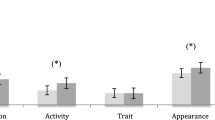Abstract
Bem's Sex-Role Inventory was used to classify 111 college men and women into masculine, feminine, androgynous, and undifferentiated sex-role categories. Subjects were tested for emotional expressivity (feminine task), assertiveness (masculine task), and personal integration. Sex typed and cross-sex typed subjects performed well only on those tasks which were congruent with their measured sex role. Androgynous subjects exhibited the greatest behavioral adaptability, performing well on both masculine and feminine tasks; undifferentiated subjects performed poorly on both tasks, but particularly so on sex-reversed tasks. Thus, behavioral flexibility was shown to derive from strong identifications with both masculine and feminine roles (androgyny) rather than from a simple lack of identification with either role. In addition, contrary to previous findings that masculine-typed women are better adjusted than feminine-typed women, androgynous and sex typed subjects both scored high in personal integration, with cross-sex typed subjects of both sexes scoring as low as undifferentiated subjects.
Similar content being viewed by others

References
Bem, S. L. The measurement of psychological androgyny. Journal of Consulting and Clinical Psychology, 1974, 42, 155–162.
Bem, S. L. Sex-role adaptability: One consequence of psychological androgyny. Journal of Personality and Social Psychology, 1975, 31, 634–643. (a)
Bem, S. L. Androgyny vs. the tight little lives of fluffy women and chesty men. Psychology Today, 1975, 9(4), 58–62. (b)
Bem, S. L., & Lenney, E. Sex typing and the avoidance of cross-sex behavior. Journal of Personality and Social Psychology, 1976, 33, 48–54.
Berzins, J. I. New perspectives on sex roles and personality dimensions. Paper presented at the meeting of the American Psychological Association, Chicago, August 1975.
Constantinople, A. Masculinity — femininity: An exception to a famous dictum. Psychological Bulletin, 1973, 80, 389–407.
Falbo, T. Sex-role typing and sex in the use of and susceptibility to influence. Paper presented at the meeting of the American Psychological Association, Chicago, August 1975.
Gay, M. L., Hollandsworth, J. G., & Galassi, J. P. An assertiveness inventory for adults. Journal of Counseling Psychology, 1975, 22, 340–344.
Gerber, L. Openness to experience, environmental conditions and classroom participation. Unpublished doctoral dissertation, University of Chicago, 1968.
Gerber, L. Measurement of statements made about emotion: An investigation of the affect cognition scale. Psychological Reports, 1972, 30, 231–235.
Heilbrun, A. B. Measurement of masculine and feminine sex role identities as independent dimensions. Journal of Consulting and Clinical Psychology, 1976, 44, 183–190.
Heist, P., & Yonge, G. Omnibus personality inventory manual, Form F. New York: Psychological Corporation, 1969.
Orlofsky, J. L. Sex-role orientation, identity formation, and self-esteem in college men and women. Sex Roles, 1977, 6, 561–575.
Orlofsky, J. L., & Ginsburg, S. D. Intimacy status: Relationship to affect cognition. Adolescence, in press.
Rachman, A. Changes in cognitive dimensions of affective responses as a result of psychotherapy. Unpublished doctoral dissertation, University of Chicago, 1965.
Spence, J. T., Helmreich, R., & Strapp, J. Ratings of self and peers on sex role attributes and their relation to self-esteem and conceptions of masculinity and feminity. Journal of Personality and Social Psychology, 1975, 32, 29–39.
Wetter, R. E. Levels of self-esteem associated with four sex role categories. Paper presented at the meeting of the American Psychological Association, Chicago, August 1975.
Whittaker, D., & Watts, W. A. Personality characteristics of a nonconformist youth subculture: A study of the Berkeley nonstudent. Journal of Social Issues, 1969, 25, 65–89.
Author information
Authors and Affiliations
Rights and permissions
About this article
Cite this article
Orlofsky, J.L., Windle, M.T. Sex-role orientation, behavioral adaptability and personal adjustment. Sex Roles 4, 801–811 (1978). https://doi.org/10.1007/BF00287700
Issue Date:
DOI: https://doi.org/10.1007/BF00287700


